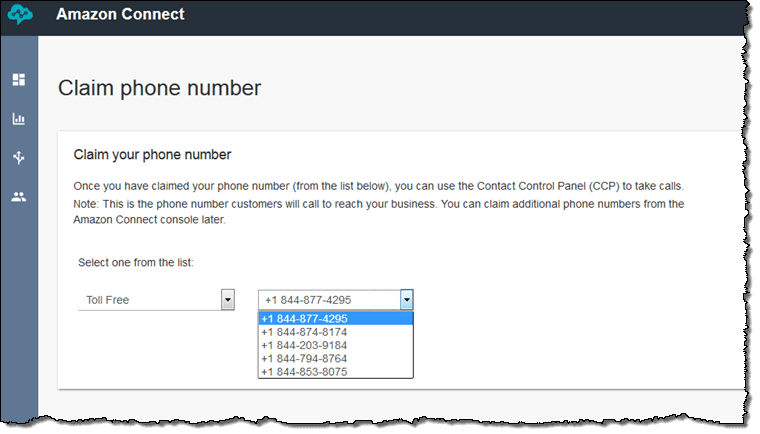
Amazon Connect Telephony
Telephony is a feature of Amazon Connect that offers a select range of telecommunication services. Amazon Connect’s cloud-based Telephony services are easy to use and provide unrivaled scalability to support businesses of diverse sizes and industries.
Amazon Connect offers a comprehensive solution to help businesses increase customer obsession and streamline their contact center operations. With Amazon Connect, you can easily handle your phone infrastructure, including carrier connections, redundancy, and routing. Whether your contact center is in the cloud or on-premises, Amazon Connect ensures seamless communication and exceptional performance.
One of the standout features of Amazon Connect is its Telephony capability, which allows organizations to make and receive calls with utmost reliability and efficiency. The built-in softphone offers high-definition sound quality, ensuring crystal-clear conversations with customers. What’s more, the platform enables intelligent call sorting based on priority and availability, ensuring that customer inquiries are promptly addressed.
Traditional contact centers often face challenges such as compliance risks, poor quality of customer care, and lack of skill-based call routing. However, Amazon Connect addresses these concerns comprehensively. With skill-based contact routing, businesses can efficiently route calls to the most suitable agents, ensuring customers are connected with the right expertise. Moreover, Amazon Connect offers voice and chat recording, enabling organizations to capture and analyze customer interactions in real-time, empowering them to continuously improve their customer service.
By leveraging the power of the AWS Connect ecosystem, businesses can unlock even more capabilities to enhance customer obsession. With services like Amazon Lex, organizations can build conversational interfaces for voice and text-based interactions, further enhancing the customer experience. Amazon Transcribe converts speech into text, making it easier to analyze and gain insights from customer interactions.
Telephony architecture
In all AWS Regions supported by <Person>Amazon Connect</Person>, you can host toll-free and direct call numbers (DID). In a single instance, users can use both kinds of phone numbers. The Amazon Connect pricing website has a detailed list of supported countries and rates, including the difference in prices between DID and toll-free numbers.
Amazon Connect is 100% cloud-based, eliminating the need for manual planning for scalability. As your business encounters fluctuations in call volume, Amazon Connect automatically adjusts, making more system resources available to your team. This dynamic scalability ensures that your team can handle an increasing number of calls without compromising the seamless quality of service your customers have come to expect.
Users can effortlessly make and receive calls, whether your contact center is hosted in the cloud or on-premises. These services’ unrivaled scalability allows businesses of diverse sizes to benefit from seamless performance. Moreover, Amazon Connect provides a built-in softphone that offers high-definition sound quality and the ability to sort calls based on priority and availability.
Within the Amazon Web Services ecosystem, various services can be utilized alongside Amazon Connect. These services include Amazon Lex, Amazon Transcribe, Amazon Contact Lens, and numerous other tools and services available within the Amazon toolbox. By leveraging these offerings, it becomes possible to construct a cutting-edge contact center solution that reduces costs and enhances capabilities under a flexible and scalable pay-as-you-go model.
With Telephony, you can effortlessly make and receive calls, ensuring smooth communication with your customers. What sets Amazon Connect apart is its exceptional scalability. As your business evolves and experiences fluctuations in customer demand, Amazon Connect’s Telephony services can easily adapt to meet your needs. Whether you need to scale up during busy periods or scale down during slower periods, Amazon Connect provides the necessary infrastructure to ensure a seamless and uninterrupted customer experience.
Within the Amazon Web Services ecosystem, various services are accessible and can be utilized alongside Amazon Connect. These services include Amazon Lex, Amazon Transcribe, Amazon Contact Lens, and numerous other tools and services available within the Amazon toolbox. By leveraging these offerings, it becomes possible to construct a cutting-edge contact center solution that not only reduces costs but also enhances capabilities, all under a flexible and scalable pay-as-you-go model.
Toll-free numbers
Toll-free numbers are telephone numbers with distinct area codes. Customers can dial these numbers from all phones with no charge to the person placing the call.
These types of numbers allow people to reach out to businesses. In addition, they provide access to companies and individuals outside their area without being charged a hefty long-distance fee.
AWS connect offers a Toll-free facility adhering to the laws governed by the local governing body. Toll-free numbers are more expensive than regular Direct dial. AWS connect goes a step further in ensuring 24×7 availability even in complete carrier failure by implementing carrier redundancy.
Flexibility
Telephony is a highly versatile and scalable feature of Amazon Connect that offers a select range of telecommunication services. With Amazon Connect’s cloud-based Telephony services, businesses of diverse sizes and industries can enjoy unparalleled scalability and flexibility. Whether your contact center resides in the cloud or on-premises, Amazon Connect’s Telephony services are designed to seamlessly handle the demands of your organization.
With Telephony, you can effortlessly make and receive calls, ensuring smooth communication with your customers. What sets Amazon Connect apart is its exceptional scalability. As your business evolves and experiences fluctuations in customer demand, Amazon Connect’s Telephony services can easily adapt to meet your needs. Whether you need to scale up during busy periods or scale down during slower periods, Amazon Connect provides the necessary infrastructure to ensure a seamless and uninterrupted customer experience.
DID numbers
Direct Inward Dialing (DID) is a telecommunication service that allows a phone number to connect directly to a specific phone without going to a queue or menu. Thus, it cuts the requirement of needing an extension to reach a particular person or business. These types of phone numbers are called DIDs and are operated by a single carrier.
Amazon AWS Connect allows DID services to its customers; however, they aren’t free. DID numbers are much more helpful and cheaper in local scenarios, as they will attract a more affordable inbound call rate.
DID numbers are single carriers; hence they cannot use the carrier redundancy facility offered by AWS connect. However, it makes them a cheaper alternative than toll-free numbers.

Claiming numbers
Amazon AWS connect allows you to claim a number in a number of supported countries. Furthermore, users can claim both Toll-free and DID numbers from various inventories maintained by AWS. Check out the list of countries and the pricing for each here.
Users can claim a set amount of phone numbers depending on the service quota selected for each instance. If you reach the desired quota and need an additional number, they have to give up one already claimed number. To claim the extra numbers, you must submit a request for a service quota increase.
Amazon Connect Partner
An Amazon Connect partner is equipped with the knowledge and experience to help you deploy complex contact center solutions on AWS.
Porting numbers in AWS
Porting numbers generally means changing the carriers without changing the number. AWS connect also offers the portability of numbers from one carrier to another.
Porting works in general under the order and regulations of local authorities. By international standards, a customer can contact a new carrier that, in this case, is the recipient, and it sends a number portability request to the current carrier (which is the donor).
In the UK and India, a user must contact the donor to obtain a code, and then that code is given to the recipient carrier. To port a number in AWS connect, a documentation process needs to be followed. You should also note that there will be Downtime and disruption of service during the porting process.
Telephony in other use cases
Amazon Connect’s Telephony feature is a game-changer for businesses seeking to revolutionize their customer service while reducing costs. With its easy-to-use and scalable cloud-based services, Amazon Connect Telephony empowers organizations of all sizes and industries to deliver exceptional customer care. Whether your contact center operates in the cloud or on-premises, Amazon Connect Telephony ensures seamless call management and superior call quality.
One of the standout features of Amazon Connect Telephony is its built-in softphone, which offers crystal-clear HD sound and enhances the overall calling experience. This softphone also provides advanced call sorting capabilities, allowing agents to prioritize and handle calls based on availability and urgency. By streamlining call management, Amazon Connect Telephony ensures that customers receive prompt and efficient assistance, leading to heightened satisfaction.
Traditional contact centers often face challenges such as compliance risks, subpar customer care quality, and a lack of skill-based call routing. However, Amazon Connect addresses these hurdles head-on by offering skill-based contact routing, voice and chat recording, real-time analysis, and much more. By leveraging these features, businesses can ensure that each customer is connected to the most appropriate agent, resulting in personalized and tailored interactions.
As your organization grows beyond the initial AWS Free Tier, you will find that scaling with Amazon Connect does not require extensive planning for resource allocation. The system is designed to automatically adjust, providing exactly what you need when you need it. Whether your team consists of 10 people or expands to tens of thousands, Amazon Connect seamlessly scales, making additional resources available in response to increased call-load demands. You pay only for the service time (how long the software in the cloud is working on your data) and your calling minutes. Both adjust monthly depending on your usage, so you’ll pay more when you’re busy, but costs drop when it’s slower – if your business is seasonal, for example.
Pricing
Additional service usage costs for Amazon Connect beyond the AWS Free Tier are charged based on the type and duration of usage. For voice usage, the following rates apply:
- Usage beyond the free tier is billed at $0.0018 per minute.
- Incoming calls on Direct Inward Dialing (DID) numbers are charged starting at $0.03 per minute.
- Incoming toll-free calls have a starting rate of $0.06 per minute.
- Outbound call charges begin at $0.0065 per minute.
For specific pricing details relevant to various AWS regions, it’s recommended to consult the Amazon Connect Pricing by AWS Region chart available on the AWS website.
Related Articles
Building an Agent with Amazon Bedrock AgentCore + Strands Agents
Building a Production-Ready Agent with Amazon Bedrock AgentCore + Strands Agents ✅ Executive Summary Organizations need scalable, secure, and...
How to Build AI Code Review Agent for GitHub
🤖 Building an AI Code Review Agent for GitHub The complete guide to creating a GitHub PR Review Assistant with Amazon Bedrock AgentCore 📋 Table of...
Replatform, Refactor, or Rehost? Choosing the Right AWS Migration Strategy
Replatform, Refactor, or Rehost? Choosing the Right AWS Migration StrategyAWS migration fundamentally transforms businesses, not just IT Systems....



